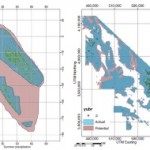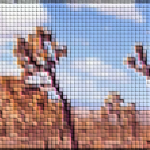Species distribution modeling
Much of my previous research is associated with some aspect of species distribution modeling (SDM), starting with my dissertation on incorporating spatial dependence in predictive vegetation models, and a number of articles that resulted from the dissertation research, including a review and several comparative application papers based on data collected in the Mojave Desert (2002, 2005, and 2006).
 I have presented this research at many national and international conferences such as GIScience, Geocomputation, and Spatial Accuracy and I have won the AAG GISS-SG student paper competition (2003), IALE best student presentation (2004), as well as the AAG Nystrom dissertation award (2004). Collaborative research funded by the National Science Foundation (#0451486) with Dr. Janet Franklin extended and expanded upon this work to develop a framework to help guide decision-making in all steps of the species distribution process. This project resulted in a comprehensive book by Franklin (Mapping Species Distributions: Spatial Inference and Prediction), in which I co-authored the chapter on statistical methods. I have attended two international workshops that focused on statistical methods used in SDM (Riederalp, Switzerland 2001 and 2005) and have organized conference sessions to discuss SDM research at AAG (2008, 2009, 2010) and the IGU (2006). More recently I was invited to write a review paper on SDM for Geography Compass.
I have presented this research at many national and international conferences such as GIScience, Geocomputation, and Spatial Accuracy and I have won the AAG GISS-SG student paper competition (2003), IALE best student presentation (2004), as well as the AAG Nystrom dissertation award (2004). Collaborative research funded by the National Science Foundation (#0451486) with Dr. Janet Franklin extended and expanded upon this work to develop a framework to help guide decision-making in all steps of the species distribution process. This project resulted in a comprehensive book by Franklin (Mapping Species Distributions: Spatial Inference and Prediction), in which I co-authored the chapter on statistical methods. I have attended two international workshops that focused on statistical methods used in SDM (Riederalp, Switzerland 2001 and 2005) and have organized conference sessions to discuss SDM research at AAG (2008, 2009, 2010) and the IGU (2006). More recently I was invited to write a review paper on SDM for Geography Compass.
 The research on spatial autocorrelation and SDM described above was based on presence/absence data collected for about 20 plant species in the Mojave Desert, CA. The data were collected as part of a larger study to develop a vegetation map and the sampling strategy used was a gradient-directed one intended to maximize floristic variation. As a result, it was difficult to make generalizations from my model comparisons about the effects of spatial autocorrelation. This sparked an interest in using simulated data to explore how things like scale, sampling strategy, statistical method and spatial structure actually do affect SDM, which was the focus of my UT Summer Research Assignment for 2008. I received an NSF grant (#0962198) in 2009 to support this research and the result will be a framework that can be used to guide all aspects of model conceptualization and development when using binary data with spatial autocorrelation. Preliminary results from a pilot study have been presented at conferences and I have been exploring how spatially explicit simulated data have been used in SDM in general, as well as how they are used in movement pattern analysis (see below). I have given invited talks on this research at the University of Utah (2010), UT (2011), and Clark University (2011) and have organized a conference session on similar research themes (AAG 2012).
The research on spatial autocorrelation and SDM described above was based on presence/absence data collected for about 20 plant species in the Mojave Desert, CA. The data were collected as part of a larger study to develop a vegetation map and the sampling strategy used was a gradient-directed one intended to maximize floristic variation. As a result, it was difficult to make generalizations from my model comparisons about the effects of spatial autocorrelation. This sparked an interest in using simulated data to explore how things like scale, sampling strategy, statistical method and spatial structure actually do affect SDM, which was the focus of my UT Summer Research Assignment for 2008. I received an NSF grant (#0962198) in 2009 to support this research and the result will be a framework that can be used to guide all aspects of model conceptualization and development when using binary data with spatial autocorrelation. Preliminary results from a pilot study have been presented at conferences and I have been exploring how spatially explicit simulated data have been used in SDM in general, as well as how they are used in movement pattern analysis (see below). I have given invited talks on this research at the University of Utah (2010), UT (2011), and Clark University (2011) and have organized a conference session on similar research themes (AAG 2012).
I have continued to explore advanced spatial issues associated with SDM, more recently looking at spatial nonstationarity and the scale of species-environment relationships in the Mojave Desert (2011, and supported by UT COLA Research Fellowship fall 2009), and using local spatial statistics to examine bird species richness relationships with climate at different spatial scales.